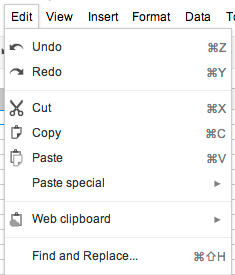If you have started using Chrome as your main web browser and continued to explore Google Docs as a way of creating and sharing documents, you have probably noticed that there are some difficulties with copying and pasting between documents, particularly actions such as copying from Microsoft Word and pasting into Google Docs. I have inserted
Google's instructions for using the Google Web Clipboard below. These should help you. It is just as easy as 'normal' copying and pasting, but has a few advantages also.
Firstly, it works on a desktop computer to paste between applications. Functioning properly is definitely a benefit! Secondly, you are able to copy/paste multiple strands of text, images, charts, etc without the web clipboard erasing your last entry. For instance, if I have an image and a strand of text, I can use Edit->Copy to Web Clipboard for each item and then use Edit -> Web Clipboard and select the text or image you want to paste. Third, you can access the Web Clipboard on multiple devices as the clips are saved in the cloud. As long as you sign into the same account, you should be able to copy something on one computer and paste it using another.
You can clear your copied items whenever you choose, otherwise, they will stay available in the Web Clipboard for 30 days. Below are the instructions from the Google Help pages.
--------------------------------------------------------------------------------------
There are a few cases in which the best way to copy and paste is using the web clipboard tool. With the web clipboard tool, you can copy more than one selection and then choose which one to paste later; it also lets you copy something on one computer and then paste it on another.
Select what you'd like to copy.
Click the Edit menu and select Web clipboard.

Click Copy selection to web clipboard.
In the destination file, click the Edit menu and select Web clipboard again; you'll see the selection that you previously copied. If you copied multiple things, you'll see a list of the items you've recently copied.
Place the cursor where you want to paste the content.
Select Web clipboard from the Edit menu.
Select what you want to paste. Depending on your selection, you'll see different formats that you can choose from to paste what you've copied (for example, HTML or plain text).
Select a format.
Drawings
You can use the web clipboard to copy shapes from drawings and paste shapes into drawings embedded in Google spreadsheets, documents and presentations, or to copy and paste a drawing from a doc into the standalone drawing editor.
Click the Edit menu, select Web clipboard, and then select Copy shapes to web clipboard. Then, open the document that you want to paste the drawing into. Select Web clipboard from the Edit menu, and then select the drawing you want to paste from the menu.
Presentations
You can't use the web clipboard to copy and paste regular text and images in Google Slides yet. You can select entire shapes on a single slide, and if the shape is a text shape, then the text will be copied to the server clipboard.
Charts
You can use the web clipboard to
copy and paste charts from a spreadsheet into a document or drawing.
How content on the server clipboard is stored and protected
You can access the content copied to the server clipboard only by signing in to the same Google Account you used to copy the content originally.
Content you copy to the web clipboard is stored on Google's servers and remains there until 30 days have passed since you last took action on (for example, copied) a given content selection. Even if a document is deleted, anything you copied from that document to the server clipboard will still exist on Google's servers for that 30-day period. You can delete all items stored on the server clipboard by clicking the drop-down menu and selecting Clear all items.





.jpg)
.jpg)

